A guide to webinar marketing: best practices & platform comparisons
A full guide for developing a webinar marketing strategy and generating leads. Find out webinar marketing best practices and a list of Zoom alternatives..
May 9, 2020
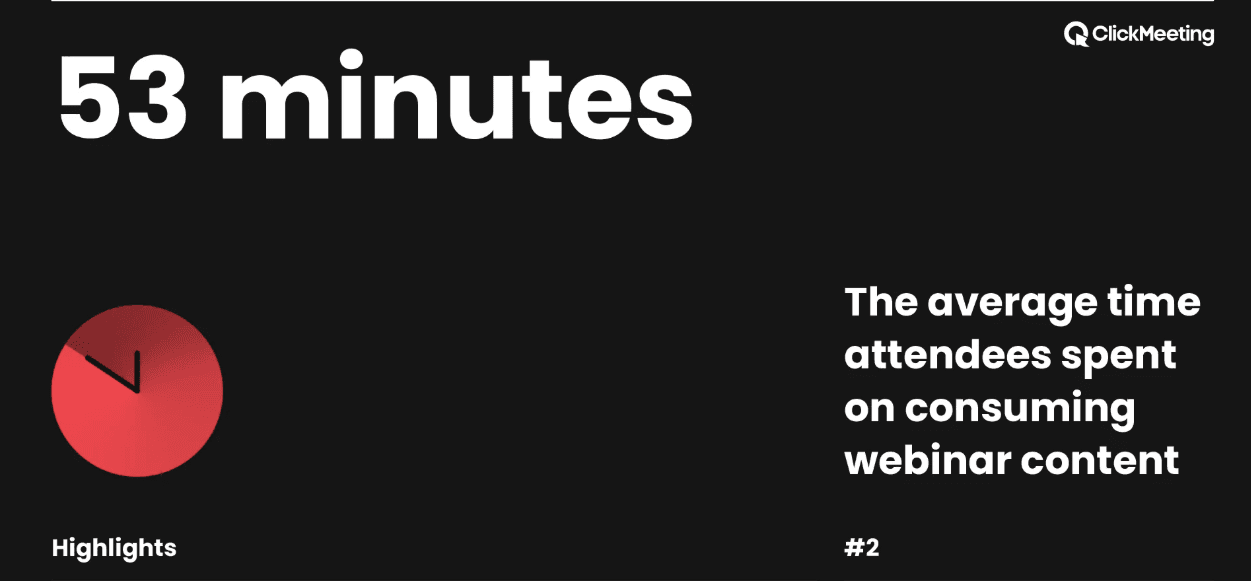
- What is a webinar?
- Why are webinars an important part of a marketing strategy?
- What is a webinar funnel?
- How to run a successful webinar? Detailed webinar marketing best practices.
- A guide to the best webinar platforms: tools to help you host a webinar
- Other notable mentions that appeared in online conversation as Zoom alternatives
- Free social media, content, and marketing webinars you can’t miss in 2020
And a free calendar of upcoming marketing webinars - download here!
So let’s take it from the very beginning and cover webinar marketing basics before we deep dive into a step by step guide for planning and hosting a successful webinar.
By the end of this blog post, you will have answers to all the following questions. Or you can jump straight to the ones you’re interested in by clicking on them below.
How can I create a successful webinar? What are the key webinar marketing best practices?
How can I conduct and set up a webinar? What are the best webinar platforms to use?
What are the Zoom alternatives out there? A list of video conferencing platforms
Where can I find free social media, content, and marketing webinars in the Middle East & Africa?
I want a calendar of free webinars!
What is a webinar?
The word ‘webinar’ is a combination of the words ‘web’ and ‘seminar,’ giving you a good indication of what it means! A seminar, lecture, or presentation given online in real-time can be referred to as a ‘webinar.’
For the Middle Eastern readers wondering what the Arabic translation of ‘webinar’ is, we actually don’t seem to have a one-word equivalent for it (yet), seeing as it’s a relatively new concept. Some people transliterate it to ‘وبينار’ but if you want to capture the meaning of webinar in Arabic you can also use the following terms:
الندوة عبر الإنترنت
نقاش عبر الويب
Webinars can offer a wide range of content such as education (online courses, training sessions, workshops, masterclasses, etc.), internal training (for your employees), and product demos (showcasing your product or service offering).
For the purposes of this blog post, I am going to explore marketing webinars which usually either offer educational content, industry insights, or showcase a marketing product or software.
Discover 50+ great marketing webinars
Why are webinars an important part of a marketing strategy?
Webinars can be a great tool for lead generation, specifically for B2B marketers.
Today, especially, webinars are a highly effective and important part of marketing strategies as they replace face to face meetings, events, and trade shows.
You can achieve the same marketing and sales goals you are used to getting from events through webinars, albeit with a little adjustment. For example, you can use webinars to:
Build a relationship with existing clients, potential prospects, and industry peers
Establish thought leadership - by sharing your expertise in your industry niche
Generate leads - by capturing the contact details of attendees
Generate revenue - it goes without saying that the ultimate goal of generating leads is to convert them to revenue
Humanize your brand - especially during these times where we find ourselves seeking human connection online
Tune in to these webinars for inspiration!
What is a webinar funnel?
To get started on building your webinar marketing strategy, we need to get down to one very important question: what is a webinar funnel?
So, just as you think of the marketing and sales funnel when you plan for events and trade shows, you need to consider the webinar funnel when you plan your webinars.
Your potential webinar attendees make up your webinar funnel. And I emphasize ‘potential’ here because even the webinar attendees who sign up for your webinar but do not end up joining or participating, are still a crucial part of your webinar funnel.
Now, your end goal here should be to move your potential webinar attendees down the entire webinar funnel and convert them to customers. We can break down the funnel into 3 main parts:
1. Top of the funnel (TOFU)
Fuelling this part of the funnel happens BEFORE the webinar date by creating a webinar marketing strategy that ensures you promote your webinar on all relevant channels and traffic sources. For more on how to outreach your webinar, keep reading or jump straight ahead to my webinar best practices.
2. Middle of the funnel (MOFU)
You’ll have a great chance of pushing your webinar participants to the middle of the funnel DURING the webinar by proving that your brand can add value. This could be a soft push (simply by sharing industry expertise) or a hard push by (showcasing your product, service, or software) depending on the nature of the webinar and your webinar marketing strategy.
Tune in to these webinars to see how other marketing experts do it!
But remember - your webinar funnel also includes potential attendees who registered for the webinar but for whatever reason couldn’t join. You can still push these potential attendees down your webinar funnel by sending out the webinar recording after the webinar - and even a series of nurturing emails. According to ON24's Webinar Benchmarks Report, over a third of all webinar attendance was on-demand - not live. This means that to truly capture your full potential audience in your webinar funnel, you need a full webinar marketing strategy.
More on than in the best practices section below!
3. Bottom of the funnel (BOFU)
If your follow-up nurturing emails receive positive replies, you have a real chance at pushing your webinar attendees down to the very bottom of the funnel and converting them to customers! This is where your sales strategy comes into play.
How to run a successful webinar? Detailed webinar marketing best practices.
Here are some key steps and webinar marketing best practices to help you create a successful webinar.
1. Create a strategic plan for your webinar
Having clearly defined goals and personas ahead of your webinar will help you identify the right type of content to prepare, and will help you put together your marketing plan (more on this below).
Touch base with your sales and customer-facing teams to find out what the key pain points prospects and customers are facing today are. Offering a solution to these problems should be central to your strategic plan.
If you skip this step, your effort could go to waste as you may end up creating great content and promoting it to the wrong audience. You may also end up creating content that attracts an audience that is not fit for your company’s strategic goals.
So - keep your business outcome crystal clear from the very beginning and at the core of your webinar marketing strategy.
As part of this step, you should also set an expected number of attendees and identify the webinar software or platform that is best suited for the business needs you outlined. Keep reading to see my detailed comparison of the features offered by the top webinar platforms or jump straight to that section.
Have you checked these upcoming webinars?
2. Select your date & duration
Give yourself at least 1 month lead time to prepare your webinar and ensure you are offering your audience quality content that adds value.
One key finding from ClickMeeting’s 2020 State of Webinars Report is that Tuesday is the best day to host a webinar.
That being said - and as with most benchmarks and KPIs - you should experiment and see what works for YOU.
Run A/B tests for different days of the week and times of the day to see what works best for your audience and your region.
You should also run A/B tests for the ideal duration for your webinars. The average event duration in 2019 was reported as 84 minutes. Your audience might appreciate this level of in-depth content - or they might prefer shorter, more concise versions.
To find out what works best here, you need to pay attention to “dwell time” or the average time spent on watching a webinar. This is how you can estimate how long you can capture your audience’s attention for.
Check out this calendar of upcoming webinars & get inspired!
3. Identify content that will resonate
Your content should resonate with the target audience you identified in your strategic plan.
It should also resonate with the current times and the industry trends. Use Quick Search and/or Google Trends to find out what your audience is looking for.
If you are wondering whether your webinar has to be related to COVID-19, the answer is no. According to Mitto’s recent survey about COVID-19 brand communications, 41% of customers surveyed are ready to hear about topics unrelated to COVID-19. And according to global experts who shared key advice on marketing during COVID-19, you shouldn’t force relevancy.
Finally, your content should be unique to you and your brand. Don’t jump on a bandwagon if you’re not an expert in that field. Remember, there are hundreds of thousands of webinars out there (literally) so your webinar needs to stand out. Run a quick competitive analysis to identify knowledge gaps you can fill.
Check out those hundreds of marketing webinars here!
4. Set up a landing page
As we’ve seen already, lead generation is one of the key benefits of hosting webinars.
To capture these leads, you need to have a landing page that is easy to use, clear, and comprehensive.
Include the fields that you require for adding leads to your database (name, company, email, phone number, industry, etc.) Be conscious of making too many of these fields mandatory though, as that could significantly decrease the sign-ups due to privacy concerns or lack of time to fill an extensive page.
Work with your design team to ensure the page is visually appealing - poorly designed landing pages are proven to lead to poor conversion rates.
Include all the important information in a clear and concise manner. Highlight the date, time, and speakers specifically as this is the key information your prospects will be looking for.
Also, ensure that the topics that will be covered in your webinar are clear without being too wordy.
Check out how marketing pros are doing it
5. Create a marketing plan for your webinar
After you select your webinar date, you will know how much time you have to prepare and promote your webinar.
Remember, a great webinar with awesome content means nothing if you don’t have an audience!
Promoting your webinar is equally important as preparing for it.
Put together a multi-channel marketing plan to promote your webinar. Consider the following channels: social media marketing, social media ads, influencer marketing, email marketing, and paid partnerships.
Don’t forget - your personal network is also an important marketing channel here. Your connections on LinkedIn, your followers on Twitter, your Facebook brand page fans, etc. are likely going to want to hear what you have to say. After all, they follow you for a reason!
Pro tip: if you co-host the webinar with an influencer, partner, or expert in your industry, you will automatically increase the potential audience size by tapping into theirs.
6. Prepare the presentation content & lead with visuals
Start by introducing yourself and your company - but be wary of being too salesy here. You don’t want to lose your audience from the get-go by giving off an impression that you are there to talk about yourself or push your product. Focus on the value you intend to offer and leave your attendees with.
You can also incentivize them to stay till the end by teasing them with the promise of a reward that will be announced at the end of the webinar (more on that below).
Often, we spend so much time fine-tuning the content of presentations that we end up skipping an equally important step - displaying that content in a visually appealing manner.
When you are conducting a webinar, you want to engage your audience for as long as possible. According to ClickMeeting’s 2020 State of Webinars Report, the average time attendees spend consuming webinar content is 53 minutes.
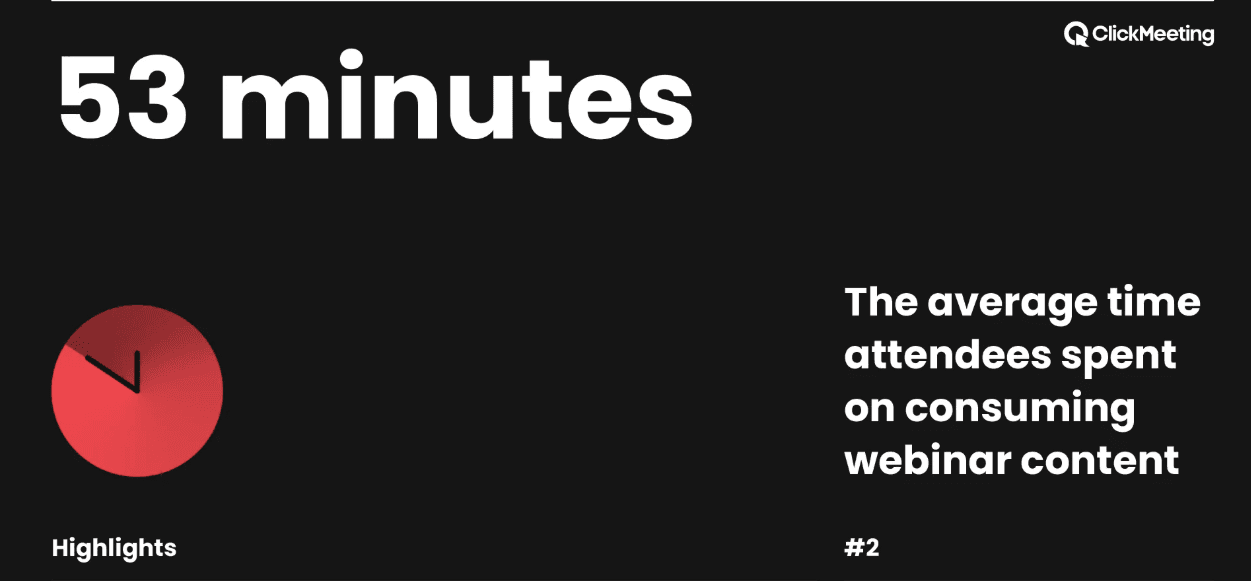
That’s great news - considering you most likely don’t manage to spend that much time with prospects at in-person events. Certainly not in a personalized manner.
Unlike face to face meetings, though, your prospects can simply leave a webinar without worrying about appearing to be rude. So, visually engaging content can be a huge asset here.
7. Engage the audience
Yes, visually-appealing content can help maintain an audience’s attention. But you should also actively engage your audience!
Common tools are interactive polls, surveys and Q&As that are interjected throughout the webinar. This is not only a good way to keep your audience engaged but also to generate interesting insights on the spot. Webinar platforms that allow attendees to talk to each other via text chat also help with audience engagement as often the attendees find value in talking to each other and sharing experiences and insights.
Tune in to these webinars to see how it’s done
Finally, offering rewards is another engagement tool. If you can offer a freebie to your audience, do it!
For instance, you can make paid content free for attendees or provide them a free demo of your product or service. This will leave a nice taste in their mouths and potentially facilitate your lead nurturing and conversion.
8. Test run
Find a location where you can control noise levels. This can be pretty challenging today with most of us working at home. Do your best to ensure your set-up is as comfortable as possible with minimal interruptions.
Test run your webinar. Find a colleague or a friend and practice with them. It’s important to do a mock presentation to ensure you do not exceed the duration you set for the webinar - and that you leave room for Q&As.
If you are co-hosting a webinar, you need to rehearse with your co-hosts to establish a cohesive flow.
9. Start the webinar with housekeeping notes
Clearly explain to your audience the format you have chosen for your webinar. For example, you should clarify how questions should be asked on your webinar - will it be by raising hands, in a text chat, or by audio at the end of the webinar? If it’s in panel format, will there be a Q&A after each speaker or at the very end?
If you are opting for interactive features (polls, surveys, etc.), you should also explain how that will work at the beginning instead of interrupting the webinar with instructions later.
If you would like your audience to tweet about your webinar using a certain hashtag, this is also the time to mention it!
Finally, if you are offering a freebie, you should mention it at the beginning of the webinar as a teaser.
10. Don’t forget about your attendees post-webinar
In my webinar funnel section, I mentioned the importance of pushing potential webinar attendees to the very bottom of the funnel through nurturing. This is when it happens!
After the webinar, share a recording of the webinar (check my webinar platform comparison below to see which platforms allow you to do that) or at the very least, a copy of the deck you presented.
This keeps you top of mind in the audience’s mind and cements your thought leadership as they may now refer back to your insights at a future date.
Either in the same email or a set of following emails, start nurturing your webinar attendees by sharing more information about your brand/product/service and showcasing clearly how it can benefit them.
The more you can personalize it (by persona or industry), the higher your chances are of getting a positive reply. You should also create different email streams for the attendees who joined you on the webinar and the potential attendees who signed up for it but ultimately did not join.
Your goal here should be to nurture the leads as much as possible to allow your sales team to convert them to customers.
Important note: while this step happens after the webinar, you should prepare it in advance during your webinar planning to ensure there is no delay. Automate the emails so that it’s simply a matter of uploading your attendee lists once the webinar is over.
A guide to the best webinar platforms: tools to help you host a webinar
Now that you have all your webinar marketing best practices down, you’re probably wondering which webinar tool or platform you should use to conduct your upcoming webinar.
Well, you’re not alone. There are many different webinar platforms out there, each with their own advantages and limitations too.
To find out what the best webinar platforms are, I used Talkwalker Analytics as a starting point to check the online conversation around webinar platforms and find out which ones were generating the most online conversation.
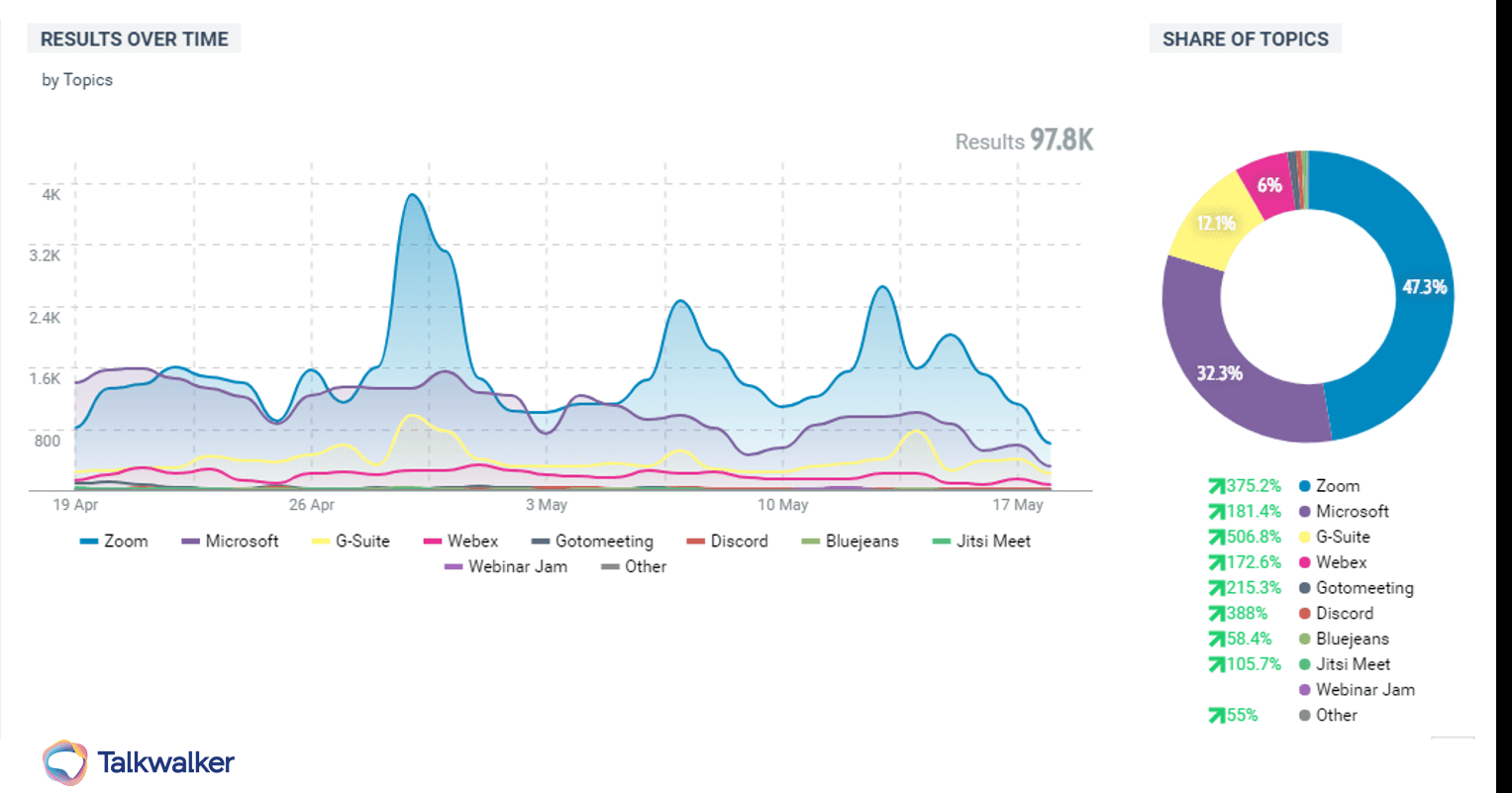
A comparison of online conversation surrounding webinar platforms in the last month in the MEA region. Source: Talkwalker Analytics
After identifying the top 5 webinar platforms based on volume of online conversation, I researched further to put together the following list of pros and cons of the features offered by each of our top 5 webinar platforms.
1. Zoom
Pros:
Free - the basic version is free of charge with no time limit on the trial period. For pricing, click here.
Easy to use - both the app and website version
High quality HD video and audio
Collaborative and interactive features - text chat, screen sharing, raising hands. You can also enable real-time captions to understand what other participants are saying during a call. This is important to consider if you would like your webinar attendees to be able to chat with each other.
Accessible - anyone can join a Zoom meeting without signing into the app. As a webinar host, you will need to sign up for an account though. Users can join a Zoom webinar on practically any platform - the Zoom app, website, or by dialling in oldschool via a phone line! This can help with webinar attendance.
Large meetings - the free version allows one host and up to 100 participants whereas the premium version supports up to 1,000 participants.
Recording - Local recording is available to free and paid subscribers, allowing participants to record meeting video and audio to their computer. Cloud recording is automatically enabled for paid Zoom subscribers from within the app, allowing users to download the recording to a computer or upload it to a file storage service on the cloud. Remember - recording webinars can help you nurture your webinar funnel.
Unlimited number of meetings - even for the basic (free) version.
Interface - Zoom is popular for its Gallery view which allows up to 49 participants on a single screen, allowing users to experience a sense of community or gathering.
Reactive - they are currently addressing the security issues (more below)
Download a free calendar of marketing webinars
Cons:
Privacy concerns - what is now known as “zoom bombing,” a recent phenomenon that involved Internet trolls joining a Zoom call and causing disruption by screen-casting offensive or disruptive material arose. This was brought to light prominently in South Africa when the National assembly Programming Committee’s virtual meeting earlier this month was interrupted.
Time limit: there is a 40-minute restriction on the basic (free) Zoom accounts.
Do users agree? Here are the top emotion themes from the
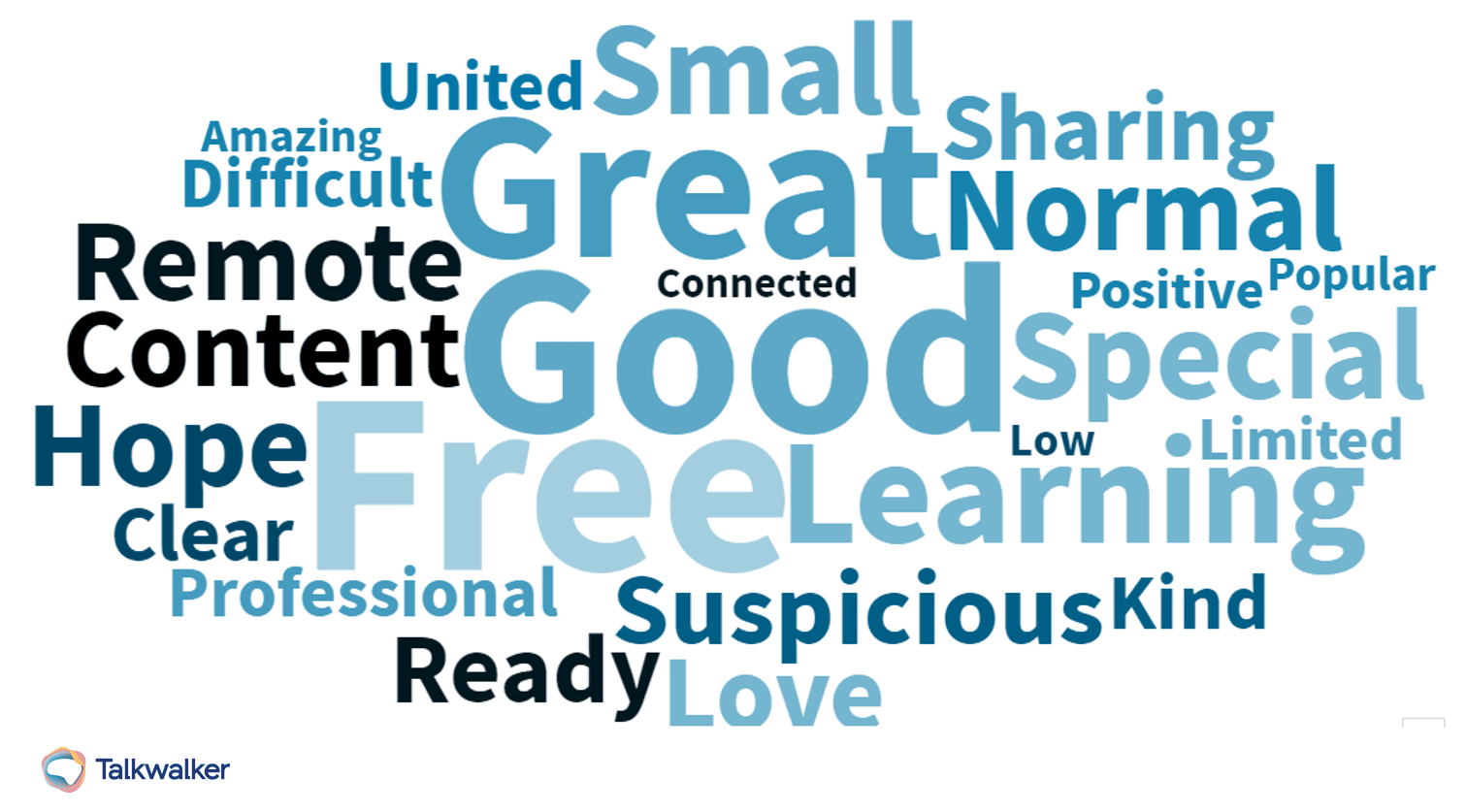
2. Microsoft (Skype, Skype for Business, Microsoft Teams)
Pros:
Reasonably priced - Skype is free (but not suited for large webinars) while Skype for Business, now replaced by Microsoft Teams, is reasonably priced.
Safe - all Skype traffic (free and paid) is encrypted with AES. Paid versions have stronger authentication methods.
Accessible - anyone can join a free or paid Skype meeting without being a Skype client. Calls from landlines and mobile phones are also supported (extra fees apply for dial-in users.)
Collaborative - you can share your desktop or mobile screen even on the free version.
Recordings - using Skype, you can record the webinar and save it for later. The final recording will be posted in the Skype chat and remain available for 30 days. You can download and save the recording to your computer any time during the 30 days. Using Microsoft Teams, here is how to record a meeting.
Fair time limits on group video calls - users are restricted to 100 hours of video calls per month with no more than 1 hours per day and 4 hours per call.
Get your free calendar of marketing webinars
Cons:
Very large meetings can not be supported - the free version allows up to 50 participants on one call whereas Skype for Business supports up to 250 participants. So, if your webinar targets are any higher than that, you might need to check another tool.
Website UX is rather clunky.
HD video is only supported on a paid plan.
Ability to join meetings from a web browser is only supported on a paid plan.
Data privacy - while it is not unsafe to use in terms of being interrupted or hacked, there are some data privacy concerns that have arisen. According to Consumer Reports, the company reserves the right to collect information from your calls, including how long a call lasts, who is participating in the call, and the IP addresses of everyone taking part.
Do users agree? Here are the top emotion themes from the
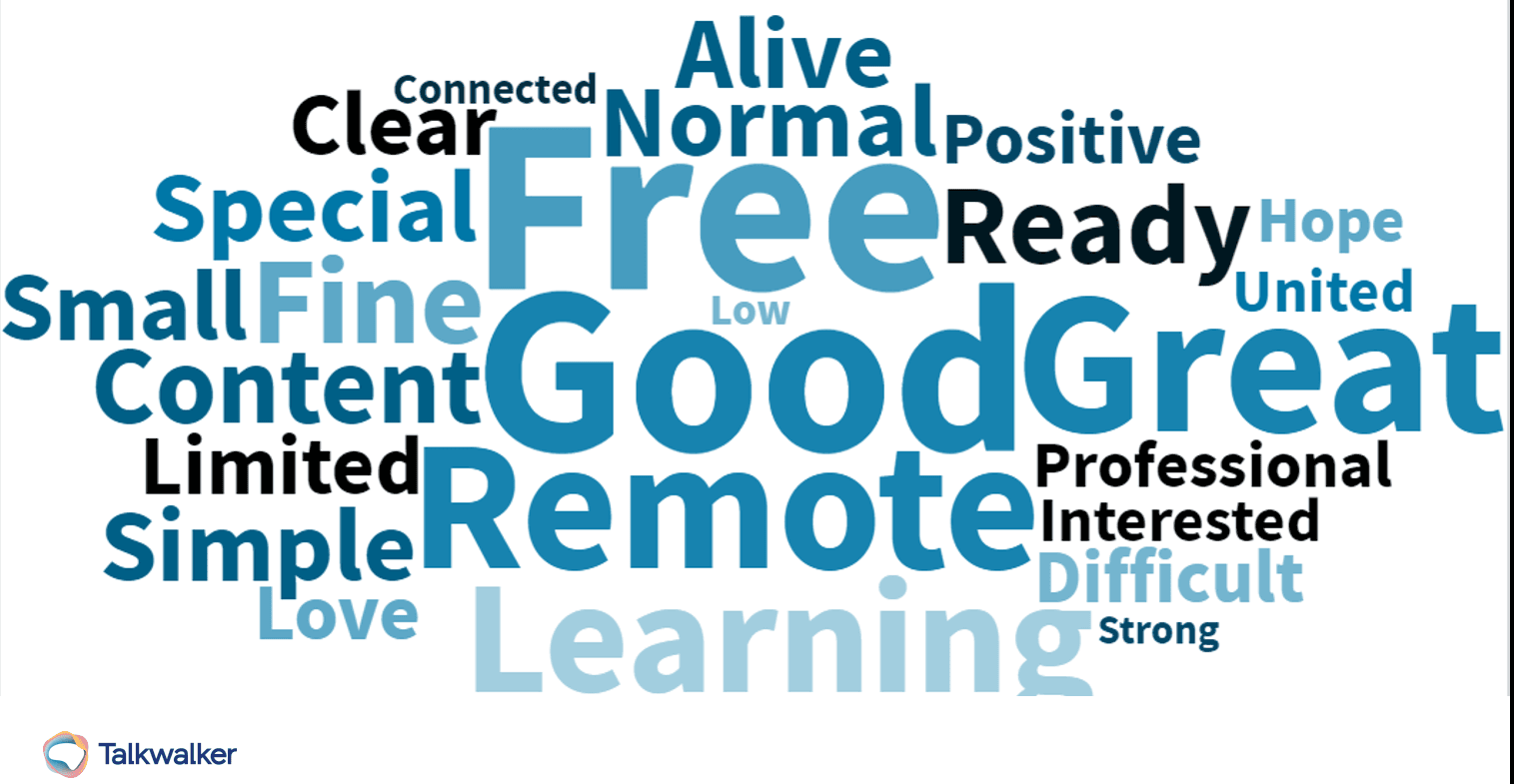
3. Google Suite (Meet, Hangouts, Duo)
Pros:
Free - Google Hangouts has historically been free and recently Google announced that any user with a work email address can access G Suite Essentials (including Meet) for free till the end of September. Pricing for Enterprise packages can be found here.
Easy to use - both setting up a meeting and joining it are made very seamless on Google Meet with one link for all meeting participants.
Collaborative and interactive features - including text chat and screen sharing. You can also enable real-time captions to understand what other participants are saying during a call.
Accessible - no need for extra plug-ins or complicated configurations. You just need to visit meet.google.com to host a meeting. Alternatively, to join a meeting, users just need to visit a link via any eligible browser including Chrome, FireFox, Safari and new Edge. Google Meet is also accessible on mobile - users will need to install the Meet app from the Apple App Store or the Google Play Store. It’s a fast, lightweight interface that users can access with little fuss.
Reliable - Meet calls pass through Google’s servers, enabling automatic captioning and troubleshooting. Google also aims to deter bad behavior by requiring participants on a (free) Meet call to sign in with a Google account.
Integration with GSuite - Meet is fully integrated with G Suite so it’s easy to join meetings directly from a Google Calendar event or email invite.
Secure - Google Meet does not use customer data for advertising (see below note about data privacy though).
A free, downloadable calendar of marketing webinars
Cons:
Very large meetings can not be supported on the free version - Google Meet access through the currently free G Suite Essentials package only allows up to 150 participants. So, if your webinar targets are any higher than that, you might need to check another tool. For the Enterprise package, Google Meet supports up to 250 participants.
Recordings - you can only record through a third-party application on the free versions. The paid package has a built-in recording feature that saves recordings directly to Google Drive.
Accessibility - Google Duo is only accessible on smartphones
Time limit on the free version - starting October, Meet will cut free calls after one hour.
Interface - Google Meet recently introduced a tiled layout that mimics the Zoom Gallery view. However, on Meet you are only able to see 16 participants at one time (versus 49 on Zoom).
Data privacy - while it is not unsafe to use Meet in terms of being interrupted or hacked, there are some data privacy concerns that have arisen. According to Consumer Reports, the company reserves the right to collect information from your calls, including how long a call lasts, who is participating in the call, and the IP addresses of everyone taking part.
Do users agree? Here are the top emotion themes from the online conversation around the Google video conferencing suite (Hangouts, Meet, and Duo) in the past month.
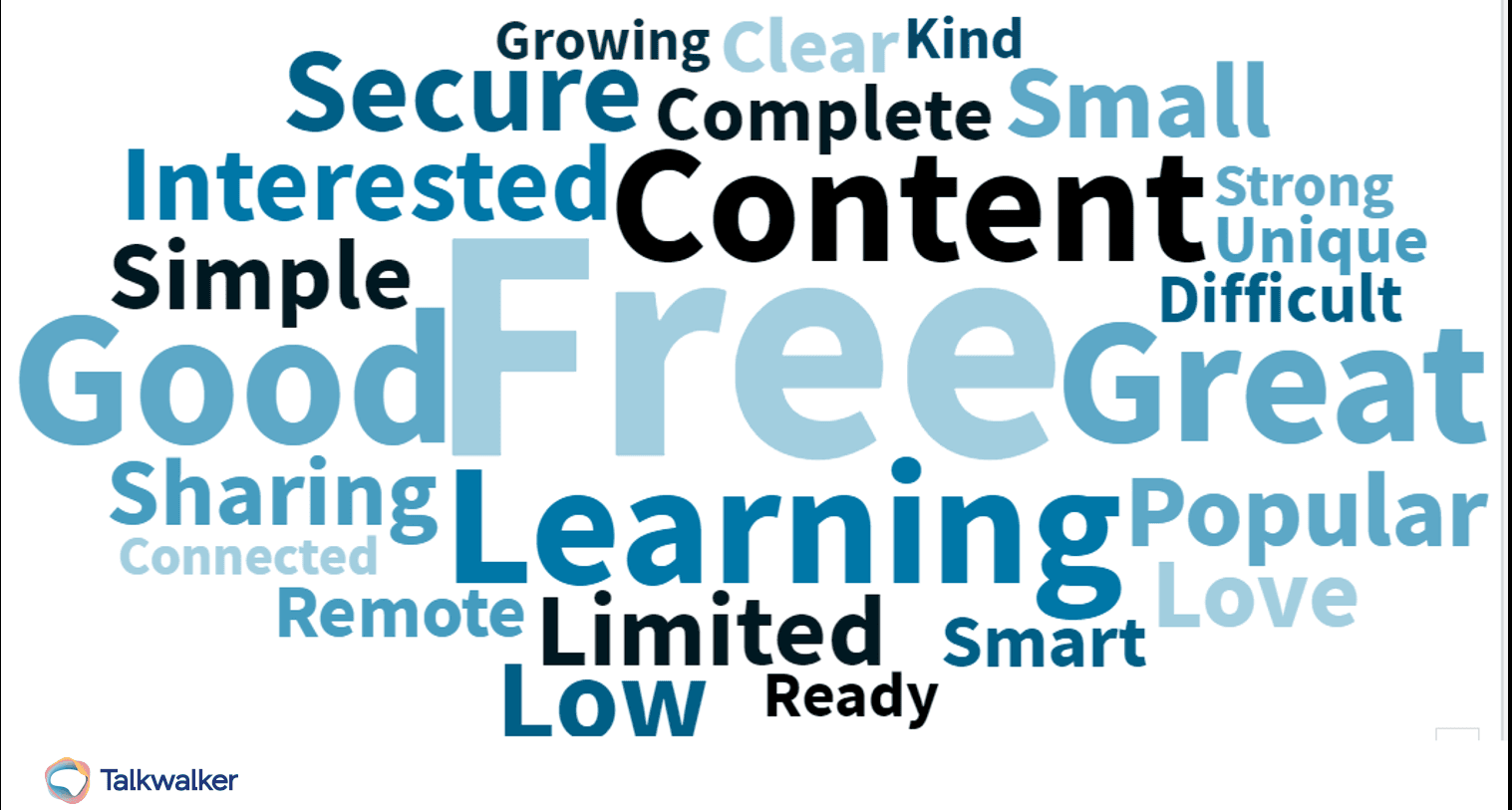
Top themes around Google-powered meetings in the last month in the MEA region filtered based on adjectives expressing emotion. Source: Talkwalker Analytics
4. Cisco Webex
Pros:
Free - for a limited time, Webex has expanded its free video conferencing features. They are also offering a free first month for any monthly plan subscription and four free months for an annual plan subscription. Pricing plans for premium offerings can be found here.
Easy to use - hosting and joining a call is straight-forward. Users can easily start or join Webex meetings directly from an Internet browser, without having to download anything.
High quality -HD video and audio.
Collaborative and interactive features-includes many collaborative features such as file sharing, screen sharing, Q&As, surveys, raising hands, and whiteboards. It is truly a versatile digital collaboration tool and not just a video conferencing platform.
Accessible-anyone can join a Webex meeting with a link. Users can also download the Webex mobile app for on-the-go calls. without signing into the app. Can support large meetings - Webex offers dedicated plans for webinars and events with webinars that can host up to 3000 participants and webcass that can reach up to 100,000 attendees! The free version only allows up to 100 participants.
Can support large meetings-Webex offers dedicated plans for webinars and events with webinars that can host up to 3000 participants and webcass that can reach up to 100,000 attendees! The free version only allows up to 100 participants.
Unlimited number of meetings-even for the basic (free) version up to 24 hours.
Secure -Webex maintains a broad and holistic approach to security in the cloud through end-to-end encryption, securing user devices and controlling what’s shared via locking spaces for moderators only.
Interface-grid view allows up to 25 participants at the same time.
Cons:
Recordings - only supported on paid plans.
Data privacy - While it is not unsafe to use in terms of being interrupted or hacked, there are some data privacy concerns that have arisen. According to Consumer Reports, the company reserves the right to collect information from your calls, including how long a call lasts, who is participating in the call, and the IP addresses of everyone taking part.
Do users agree? Here are the top emotion themes from the online conversation around Webex meetings in the past month.
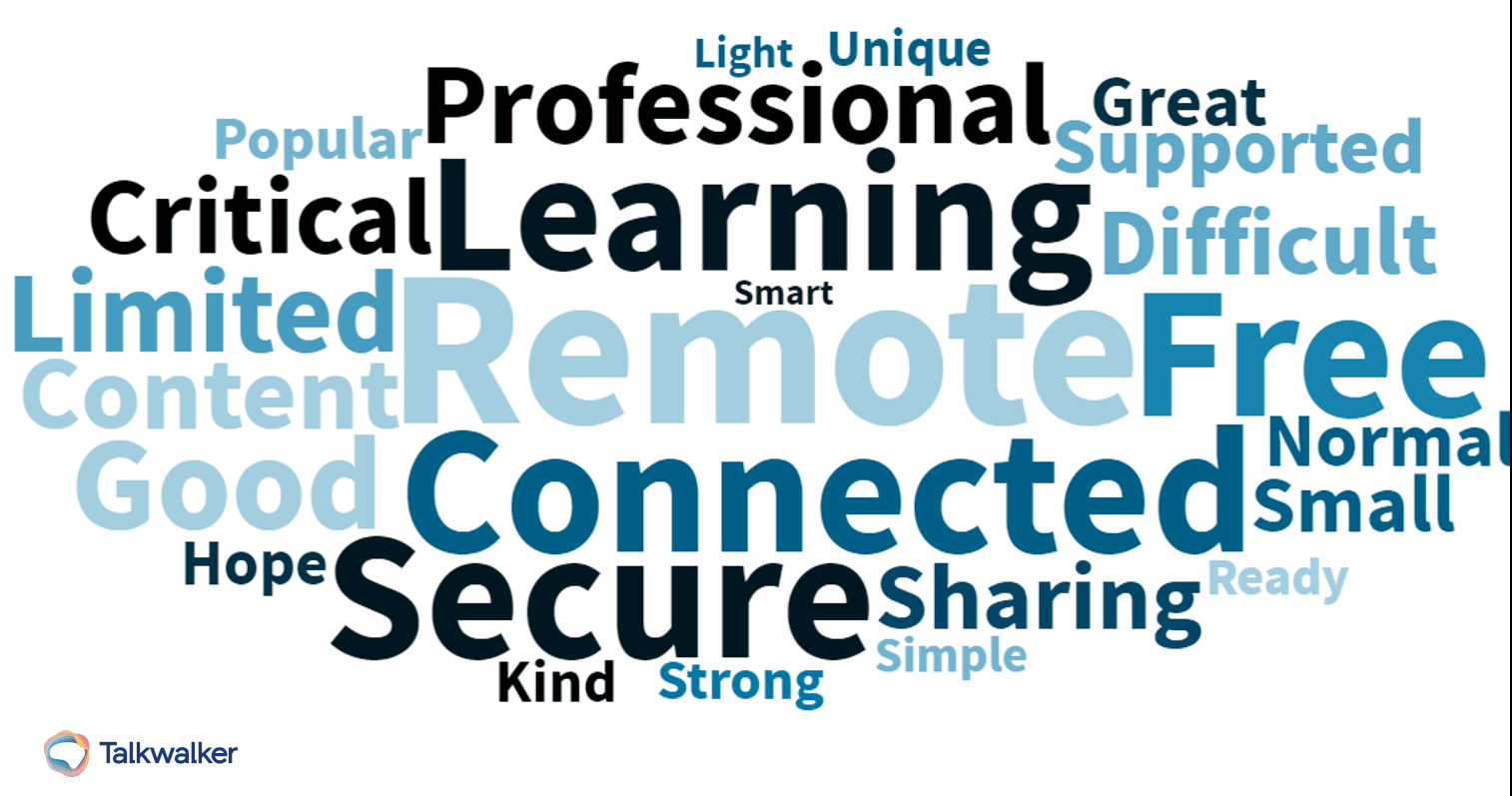
Top themes around Webex meetings in the last month in the MEA region filtered based on adjectives expressing emotion. Source: Talkwalker Analytics
5. GoToMeeting/ GoToWebinar
Pros:
Easy to use - joining a webinar is simply done through a browser and entering the webinar ID provided by the organizer.
Interactive features - includes polls, handouts, and Q&A.
Can support large meetings - GoToWebinar offers paid plans that allow up to 1000 participants.
Recordings - online and local recordings are available on the most basic plans provided by GoToWebinar. You can build awareness and demand by publishing your recorded webinars on GoToStage, a business video platform for professionals.
Secure - sessions held on GoToWebinar are completely private and secure thanks to their end-to-end Secure Sockets Layer (SSL) and Advanced Encryption Standard (AES) encryption. Unencrypted information is not stored on their system.
Integration - can be integrated with your CRM and lead generation softwares.
Versatile - they offer different formats to suit your end goal - GoToMeeting is ideal for discussions and interactions in a group format, whereas GoToWebinar provides a speaker/audience format which is generally more suitable for webinars
Automated emails - using GoToWebinar, you can create custom email invitation confirmations and reminders or even use templates offered by the platform.
Custom branding - you can display your company logo and customer image on all webinar materials.
Post-webinar reporting - GoToWebinar provides detailed reports including number of registered guests, attendance, polls, and survey responses. They have also introduced a new feature ‘1 Channel Page’ that allows you to create a customizable landing page where anyone can watch your recorded webinars on demand.
Cons:
Free offering is very limited compared to competitors. GoToMeeting offers a 7-day free trial with up to 100 attendees. More details on pricing can be found here.
Limited collaborative features - attendees cannot communicate with each other using chat on GoToWebinar.
Do users agree? Here are the top emotion themes from the online conversation around GoToMeeting and GoToWebinar in the past month.
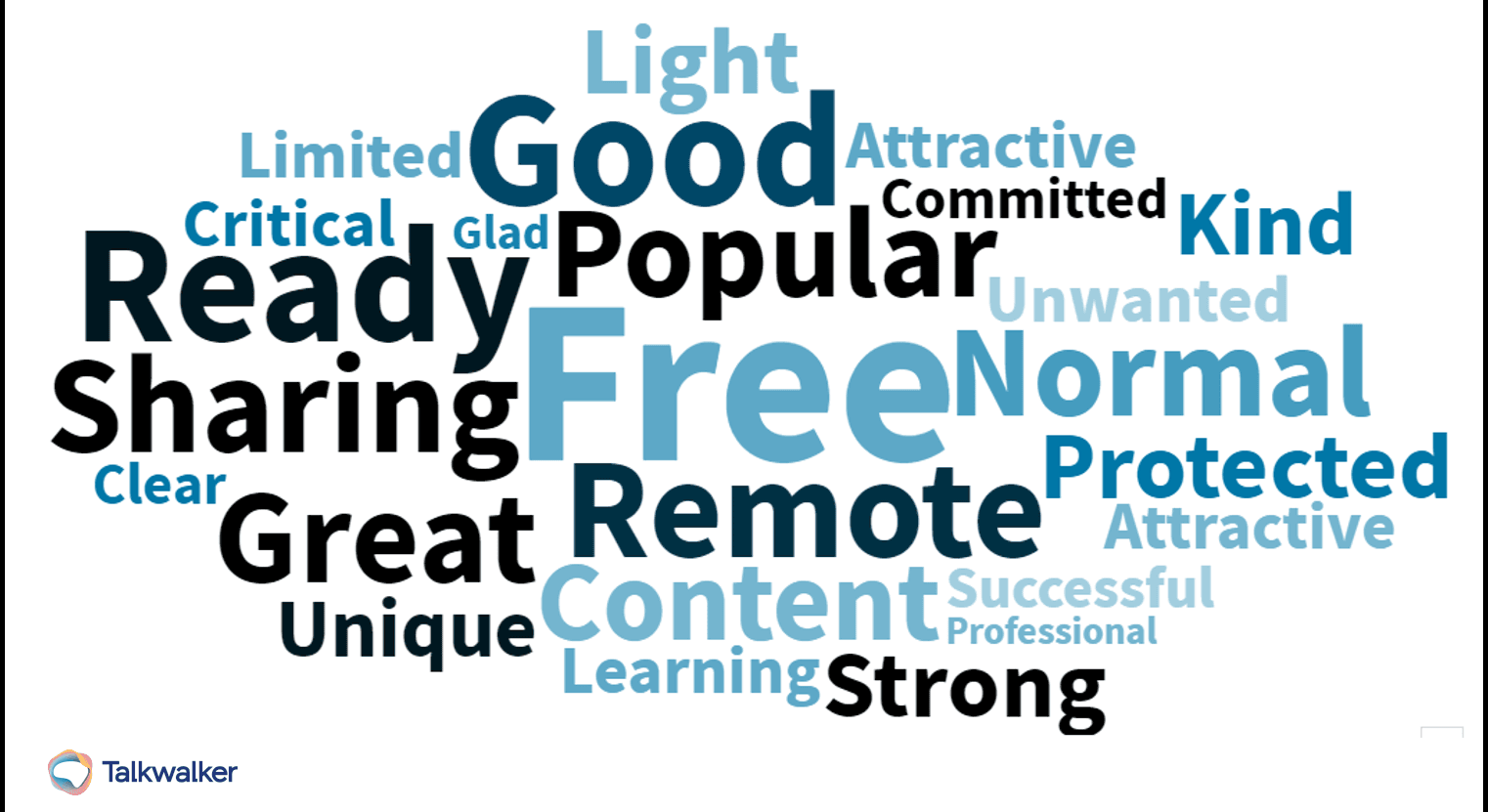
Top themes around GoToMeeting and GoToWebinar meetings in the last month in the MEA region filtered based on adjectives expressing emotion. Source: Talkwalker Analytics
Other notable mentions that appeared in online conversation as Zoom alternatives
Because sometimes, it’s good to give the unusual suspects a chance!
WebinarGeek
Free social media, content, and marketing webinars you can’t miss in 2020
Especially curated for the Middle East & Africa audience - featuring regional speakers and/or taking place in a suitable time zone!
Download the full calendar of webinars here
Entrepreneur.com: Simple Marketing Techniques to Re-Engage with Customers and Make Them Feel Safe
This webinar will focus on how marketing is changing and new ways and platforms for sending your marketing messages to your customer and target markets. The webinar will also focus on what is important to consumers and what it will take for them to feel safe and trust businesses after the pandemic.
When: June 8, 2020 10PM CEST
DMWF & Electric House: Social Media while Social Distancing
Senior Client Partner Will Bonaddio will be discussing how social media has changed in the time of social distancing, and how a brand's purpose is key to achieving success and cut-through now more than ever.
Plus, using their own leading communities On The Tools and On A Budget, he'll provide industry insights and wider consumer trends to be aware of right now in order to help shape your marketing strategy.
When: June 9, 2020 3PM BST
IAB South Africa & Kantar: Insights
IAB South Africa and Kantar have initiated a series of online weekly talks, powered by Kantar's bi-weekly surveys to get a pulse on how the pandemic has impacted advertising spend, marketing strategies and business operations across our industry. We’ll hear about the innovations, best practices and alternative measures coming into view that can help us all minimize the risk to our businesses #IABinsights
When: June 10, 2020 9AM Johannesburg time (and every following Wednesday)
On24: How to drive pipeline with an on-demand webinar strategy
According to the recent ON24 Webinar Benchmarks Report, over a third of all webinar attendance was on-demand – NOT LIVE. This means that to truly capture your full potential audience, you need an integrated on-demand webinar strategy. Tune in to learn:
How to re-purpose webinars after the live date is over
Creating on demand webinar content for each stage of the buying cycle
Building Netflix-style on demand content hubs
How to use on demand webinars to fuel ABM programs
When: June 17, 2020 at 11AM BST
JBH: Digital PR Fails - What can you do when your campaign goes sideways?
Digital PR campaign fails are something we all experience – whether we work client or agency side, but they are never easy to swallow and are rarely discussed outside the office.
A very frank webinar hosted by Jane Hunt, co-founder of JBH – three leading PRs will discuss campaigns that kept them awake at night, providing examples of what could & could not be rescued to help you avoid similar mistakes.
When: June 23, 2020 at 1PM BST
AnswerThePublic - How observing online behavior can help you produce better content
AnswerThePublic's Hannah Harris chats to Eric deLima Rubb from Buzzsumo and Search Listening's Sophie Coley about how observing people’s behaviour online will help to supercharge your content.
Tune in to:
Understand how search data can help you read people’s minds and create higher performing content
Uncover how thinking both literally and laterally will help you understand what people really want to know
Reveal how combining data sources will help you get the full picture of how people behave online
When: June 24, 2020 at 4:30PM BST
HubSpot & GLIDR - When is it the right time to kill a feature?
Product marketers are usually so focused on the next new feature or product to build -- but when should they be focused on *killing* a feature or killing a product?
It may not be the most fun part of being a Product Manager, but it is still a part of the job. In this discussion, Daria will share her thoughts on this and more.
When: July 17, 2020
Talkwalker - COVID-19 Conversations
Ending with our very own webinar series which takes place every Tuesday. We look at the top insights on COVID-19 conversations week after week to help you keep up with the changing customer needs and communications landscape.
When: Every Tuesday!
There are SO many more webinars about marketing, PR, SEO, social media, and content coming up and it’s a great learning opportunity that we have at our fingertips today. I’ve put together a full calendar of these webinars and virtual events that is free to download - you will be spoiled for choice with multiple webinars taking place every single day!

